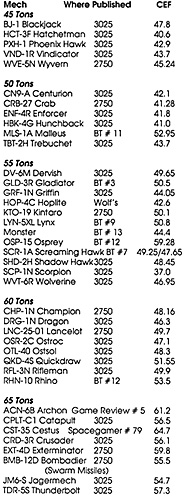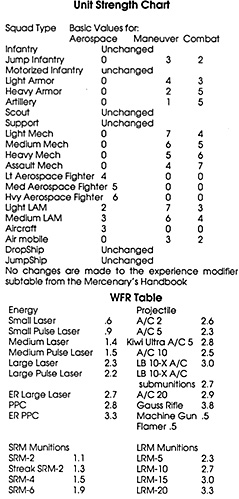Following the Grey Death Legion's Discovery of a Star League Computer Memory Core, all of NAIS has been busy for two decades learning what can be discovered. Besides the advances in technology, the core has made it possible for NAIS to expand in several other fields.
We have always been a forerunner in Mechwarrior training, and we now have made another breakthrough in simulator combat. Combining our old system with the one used by the Star League Defense Force, we have come up with a new, more intensive and rewarding training simulation system. In addition to new training-class and holographic simulators, we have redesigned the old Combat Efficiency Factor system (published in BattIeTechnoIogy in the December 3028 issue.)
The new system was dubbed the Star Simulator Rating, it incorporated old Star League data and simulations of Lostech equipment and vehicles. Today's Federated Commonwealth mechwarrior trainee will be ready for the day when Lostech is once again an integral part of the Inner Sphere.
In keeping with their policy of remaining as open and free as possible within the Inner Sphere, the Federated Commonwealth has released the New CEF:
To calculate the Combat Efficiency Factor of a BattleMech, you'll need a comp pad, Rating tables, and the performance specs for the Mech.
Step 1: Divide tonnage by 10 - Record
Step 2: Record armor tonnage
- If using Ferro-Fibrous armor, see SEFR table entry # 7
Step 3: Record walking MPs
- If equipped with MASC unit, see SEFR table entry # 5
Step 4: Add .75 for each jump jet
Step 5: Calculate Weapons Factor Rating and record
Step 6: Calculate Safe Weapons Factor Rating
- Use WFR Table to calculate the most efficient use
of Mech's weapons short of overheating - record.
Step 7: If after Safe WFR is calculated one or more heat sinks remain unused, add 1.0
Step 8: Calculate Hand to Hand Damage Factor record
- Use DFR Table
Step 9: Calculate Special Equipment Factor Rating record
- Use SEFR Table to add points for special equipment
Step 10: Total steps 1-9 to determine CEF.
DFR Table
Tonnage Rating
15 3
20 4
25 5
30 6
35 7
40 8
45 9
50 10
55 11
60 12
65 13
70 14
75 15
80 16
85 17
90 18
95 19
100 20
WFR Table
Energy
Small Laser .6
Small Pulse Laser .9
Medium Laser 1.4
Medium Pulse Laser 1.5
Large Laser 2.3
Large Pulse Laser 2.2
ER Large Laser 2.7 A/C 20 2.9
PPC 2.8
ER PPC 3.3
Projectile
A/C 2 2.6
A/C 5 2.3
Kiwi Ultra A/C 5 2.8
A/C 10 2.5
LB 10-X A/C 3.0
LB10-X A/C submunitions 2.7
Gauss Rifle 3.8
Machine Gun .5
Flamer .5
SRM Munitions
SRM-2 1.1
Streak SRM-2 1.3
SRM-4 1.5
SRM-6 1.9
LRM Munitions
LRM-5 2.3
LRM- 10 2.7
LRM- 15 3.0
LRM-20 3.3
 Combat Efficiency Factor for Most BattleMechs
Combat Efficiency Factor for Most BattleMechs
Mech Where Published CEF
10 tons
MTE-12C Mlite Star Date v 3/6 15.7
15 tons
GRD- IN Guardian BT# 13 16.7
FLE- 14 Flea BT#824.3
20 tons
FLE-4 Flea Wolf's 21.5
FLE- 15 Flea Wolf's 26.0
HNT-151 Hornet Wolf's 27.35
MCY-99 Mercury 275026.36
LCT-IV Locust 302523.8
STG-3R Stinger 302525.3
THE-N Thorn 275028.2
WSP-1A Wasp 302525.5
25 Tons
COM-20 Commando 3025 27.1
MON-66 Mongoose 2750 30.9
30 Tons
FLC-4N Falcon BT / Wolf's 33.7
FFL-4A Firefly Wolf's 39.1
HER- IS Hermes 2750 31.2
HSR-200-D Hussar 2750 26.08
JVN-ION Javelin 3025 32.1
SDR-5V Spider 3025 33.1
UM-R50 UrbanMech 3025 25.7
VLK-QA Valkyrie 3025 32.95
35 Tons
FS9-H Firestarter 3025 37.6
JR7-D Jenner 3025 37.65
0TT-7J Ostscout 3025 32.8
PNT-9R Panther 3025 32.6
WLF-1 Wolfhound BT #6/Wolf's 37.1
40 Tons
ASN-21 Assasin 3025 39.35
CDA-2A Cicada 3025 31.8
CLNT-2-3T Clint 3025 38.2
HER-2S Hermes II 3025 34.9
STN-3L Sentinel 2750 33.9
VL-2T Vulcan 3025 38.5
WTH-Whitworth 3025 42.1
70 Tons
ARC-2R Archer 3025 55.9
BTX-7K Battleax BT #5 56.0
GHR-5H Grasshopper 3025 61.4
GLT-3N Guillotine 2750 65.54
WHM-61? Warhammer 3025 56.3
75 Tons
BL6-KNT Black Knight 2750 62.76
FLS-8K Flashman 2750 68.6
MAD-3R Marauder 3025 55.2
ON 1-K Orion 3025 56.8
80 Tons
AWS-8Q Awesome 3025 58.2
BLR- 1A Brawler BT# 13 59.39
CGR-5B Challenger BT #3 62.4
CGR-1A1 Charger 3025 45.0
GOL-14 Goliath 3025 59.1
THG- 11 E Thug 2750 66.16
VTR-9B Victor 3025 56.5
ZEU-6S Zeus 3025 58.9
85 Tons
LGB-OW Longbow Sorenson's 59.1
BLR-1G Battlemaster 3205 67.6
SHG-2E Shogun Wolf's 67.75
STK-3F Stalker 3025 73.0
CRK-5003-1 Crockett 2750 72.35
90 Tons
BRN-1 Brian BT#13 76.3
CP 10-Z Cyclops 3025 57.5
HGH-732 Highlander 2750 72.41
95 Tons
BNC-3E Banshee 3025 57.9
BNC-3S Banshee BT #3 73.6
100 Tons
ALI-1 A Alliance BT #7
ANH-1A Annihilator Wolf's 72.9
AS7-0 Atlas 3025 75.2
IMP-2E Imp Wolf's 79.5
MAD-4A Marauder II 3025 74.35
Matchmaker Star Date 70.6
PLG- 1 N Pillager Star Date v3 #5 70.1
RMG-2A Rampage Classified 84.3
KGC-000 King Crab 2750 69.82
TIT- 1A Titan BT# 11 85.6
TYR-9T Tyrant Game Review#4 82.0
End Notes
# 1 Some BattleMechs are designed for specific missions, or for operations in specific terrain. Example: both the UrbanMech and the Hatchetman are city fighting Mechs. When a BattleMech is operating in such a specific environment, add 5.0 to the CEF. When it it operating outside of it, the gamemaster may choose an appropriate negative modifier. Example: in open terrain where speed and longrange firepower are major factors, the UrbanMech especially will be at a serious minus. This only applies to Mechs which are designed with such a specialty in mind.
# 2: Many mercenary units use the famed Mercenary's Handbook (FASA Corporation) when preparing a mission. They use the tactical tables to determine percentage chances of success on any given mission. As Star Leagues BattleMechs and units outperform their Thirty- first Century counterparts, use the added Unit Strength Chart presented here to calculate Star League Vehicles' superior operational capabilities.
# 3: NAIS, working with NAMA Tactics Division, is in the process of reworking the conventional units' CEF Simulation System to be compatible with this new BattleMech Simulation System. Once this is perfected it will be released to the public.

Back to BattleTechnology 13 Table of Contents
Back to BattleTechnology List of Issues
Back to MagWeb Magazine List
© Copyright 1990 by Pacific Rim Publishing.
This article appears in MagWeb.com (Magazine Web) on the Internet World Wide Web.
Other military history articles and gaming articles are available at http://www.magweb.com